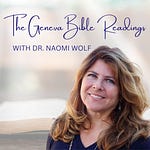In these chapters, YHWH continues the process of giving direction to Moshe, about how to construct an "aron", a cabinet or "ark", in which He will live and from which He will communicate to the Children of Israel. The construction guidance is detailed. What is striking about the original Hebrew, and the Geneva Bible translation, is that the "tabernacle" (from the Greek for "tent," or "hut") had in the original Hebrew a "court" where the people could gather, outside of an embroidered veil that separated the "Miskan", the actual place of YHWH's dwelling, from the rest of the people.
In the previous chapters, YHWH made clear that the construction of the "mishkan" -- His dwelling-place -- out of gold, with cherubs facing one another at the top -- would function almost as a radio receiver, or some other communications technology, that would allow him to communicate with Moshe or the priests directly.
In these chapters, the artistry involved with the "aron" itself and also with the whole complex, reveals (as I read it) that God loves art and artistry and speaks to us through it, and that our love for art and artistry brings us closer to God and allows us to speak with Him.
Also surprising to those of us who have never read the Hebrew, or the Geneva Bible, is the fact that a veil separated the "Mishkan" (same root as "neighbor" "one who dwells near"), is the fact that there was a courtyard that was quite large, where the table for the "showbread" was located, and the menorah that illuminated it, and "the people" were expected or invited to be present there. The later ecclesiastical and exclusively priestly functions and qualities of engaging with God near the "ark of the covenant" are not in the original Hebrew, though in the Hebrew it is true that only the priest enters the Holy of Holies. Others too, in the original, may draw near. It seems that the Priests alone entered the Holy of Holies but the people could draw near, outside the curtain separating the two sections.
The other striking thing about this description in the Hebrew is that the whole complex is called "the Tent of Meeting". I would wager that the way you were taught about the Ark of the Covenant did not include the idea of a more inclusive "tent of meeting." I was not taught about the more inclusive "tent of Meeting" either.
So Western religious memory kept the ark itself but lost to the mists of historical and ecclesiastical memory, the fact that the original instructions from God to Moshe included a "tent of meeting" where others too could assemble and also be present near the Presence of God.
Please Support Our Sponsors
The Wellness Company - Use code OUTSPOKEN for 10% off!
Kirk Elliott Precious Metals
Amazon Store: https://www.amazon.com/shop/dailyclout.io/list/2L9I6L5UZR76J?ref_=cm_sw_r_cp_ud_aipsflist_aipsfdailyclout.io_GVMSC52H5PPEP28F655S













Share this post